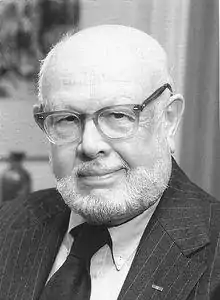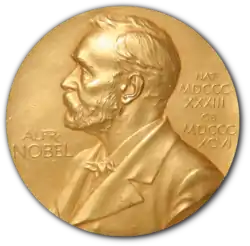William Alfred Fowler
William Alfred Fowler (August 9, 1911 – March 14, 1995) was an American nuclear physicist, later astrophysicist, who, with Subrahmanyan Chandrasekhar won the 1983 Nobel Prize in Physics. He is known for his theoretical and experimental research into nuclear reactions within stars and the energy elements produced in the process.[1]
William Alfred Fowler | |
|---|---|
 | |
| Born | August 9, 1911 |
| Died | March 14, 1995 (aged 83) |
| Other names | Willy Fowler |
| Alma mater | Caltech (PhD) |
| Awards | Barnard Medal for Meritorious Service to Science (1965) Tom W. Bonner Prize in Nuclear Physics (1970) Vetlesen Prize (1973) National Medal of Science (1974) Eddington Medal (1978) Nobel Prize in Physics (1983) |
| Scientific career | |
| Doctoral advisor | Charles Christian Lauritsen |
| Doctoral students | J. Richard Bond, Donald Clayton, F. Curtis Michel |
Early life
On August 9, 1911, Fowler was born in Pittsburgh, Pennsylvania. Fowler's parents were John MacLeod Fowler and Jennie Summers Watson. Fowler was the eldest of his siblings, Arthur and Nelda.[2][1]
The family moved to Lima, Ohio, a steam railroad town, when Fowler was two years old. Growing up near the Pennsylvania Railway Yard influenced Fowler's interest in locomotives. Later in 1973, he would travel to the USSR just to observe the steam engine that powered the Trans Siberian Railway plying the nearly 2,500-kilometer route that connects Khabarovsk and Moscow.[3]
Education
In 1933, Fowler graduated from the Ohio State University, where he was a member of the Tau Kappa Epsilon fraternity. In 1936, Fowler received a Ph.D. in nuclear physics from the California Institute of Technology in Pasadena, California.[4][5]
Career
In 1936, Fowler became a research fellow at Caltech. In 1939, Fowler became an assistant professor at Caltech.[4]
Although an experimental nuclear physicist, Fowler's most famous paper was "Synthesis of the Elements in Stars", coauthored with Cambridge cosmologist Fred Hoyle and in collaboration with two young Cambridge astronomers, E. Margaret Burbidge and Geoffrey Burbidge. That 1957 paper in Reviews of Modern Physics[6] categorized most nuclear processes for origin of all but the lightest chemical elements in stars. It is widely known as the B2FH paper.
In 1942, Fowler became an associate professor at Caltech. In 1946, Fowler became a Professor at Caltech. [4]
Fowler succeeded Charles Lauritsen as director of the Kellogg Radiation Laboratory at Caltech, and was himself later succeeded by Steven E. Koonin. Fowler was awarded the National Medal of Science by President Gerald Ford.[7]
Fowler won the Henry Norris Russell Lectureship of the American Astronomical Society in 1963, the Vetlesen Prize in 1973, the Eddington Medal in 1978, the Bruce Medal of the Astronomical Society of the Pacific in 1979, and the Nobel Prize in Physics in 1983 for his theoretical and experimental studies of the nuclear reactions of importance in the formation of the chemical elements in the universe (shared with Subrahmanyan Chandrasekhar).[8][9]
Fowler's doctoral students at Caltech included Donald D. Clayton.
Personal life
A lifelong fan of steam locomotives, Fowler owned several working models of various sizes.[10]
Fowler's first wife was Adriane Fay (née Olmsted) Fowler (1912-1988). They had two daughters, Mary Emily and Martha.[2][11]
In December 1989, Fowler married Mary Dutcher (1919-2019), an artist, in Pasadena, California.[2][11]
On March 11, 1995, Fowler died from kidney failure in Pasadena, California. He was 83.[2][12]
Publications
- Fowler, W.A.; Lauritsen, C.C; Lauritsen, T. (1948). "Gamma radiation from light nuclei under proton bombardment" (PDF). Physical Review. 73 (2): 181–182. Bibcode:1948PhRv...73..181F. doi:10.1103/physrev.73.181.2.
- Cook, C.W.; Fowler, W.A.; Lauritsen, C.C.; Lauritsen, T. (1957). "B12, C12 and Red Giants". Physical Review. 107 (2): 508. Bibcode:1957PhRv..107..508C. doi:10.1103/physrev.107.508.
- Clayton, Donald D.; Fowler, W.A..; Hull, T.E.; Zimmerman, B.A. (1961). "Neutron capture chains in heavy element synthesis". Annals of Physics. 12 (3): 331–408. Bibcode:1961AnPhy..12..331C. doi:10.1016/0003-4916(61)90067-7.
- Burbidge, E. M.; Burbidge, G. R.; Fowler, W. A.; Hoyle, F. (1957). "Synthesis of the Elements in Stars". Reviews of Modern Physics. 29 (4): 547–650. Bibcode:1957RvMP...29..547B. doi:10.1103/RevModPhys.29.547.
- Fowler, W. A. (1958). "Temperature and Density Conditions for Nucleogenesis by Fusion Processes in Stars". W. K. Kellogg Radiation Laboratory. OSTI 4308210. Cite journal requires
|journal=(help) - Seeger, P. A.; Fowler, W. A.; Clayton, Donald D. (1965). "Nucleosynthesis of heavy elements by neutron capture". Astrophysical Journal Supplement Series. 11: 121. Bibcode:1965ApJS...11..121S. doi:10.1086/190111.
- Bodansky, D.; Clayton, Donald D.; Fowler, W.A. (1968). "Nucleosynthesis during silicon burning". Physical Review Letters. 20 (4): 161–164. Bibcode:1968PhRvL..20..161B. doi:10.1103/physrevlett.20.161.
- Holmes, J.A.; Woosley, S.E.; Fowler, W.A.; Zimmerman, B.A. (1976). "Tables of thermonuclear-reaction-rate for neutron-induced reactions on heavy nuclei". Atomic Data and Nuclear Data Tables. 18: 305. Bibcode:1976ADNDT..18..305H. doi:10.1016/0092-640x(76)90011-5.
- Caughlan, G.R.; Fowler, W.A.; Zimmerman, B.A. (1975). "Thermonuclear reaction rates, II". Annu. Rev. Astron. Astrophys. 13: 69–112. Bibcode:1975ARA&A..13...69F. doi:10.1146/annurev.aa.13.090175.000441.
Obituaries
- Woosley, Stanford E. (1995). "Obituary: William A. Fowler, 1911-1995". Bulletin of the American Astronomical Society. 27 (4): 1475. Bibcode:1995BAAS...27.1475W.
- Clayton, Donald D. (1996). "William Alfred Fowler (1911-1995)". Publications of the Astronomical Society of the Pacific. 108 (719): 1–7. Bibcode:1996PASP..108....1C. doi:10.1086/133686. JSTOR 40680678.
- Burbidge, G. (1996). "William Alfred Fowler, 1911 - 14 March 1995". Quarterly Journal of the Royal Astronomical Society. 37 (1): 89. Bibcode:1996QJRAS..37...89B.
References
- Oakes, Elizabeth (2007). Encyclopedia of World Scientists, Revised Edition. New York: Facts on File, Inc. pp. 245. ISBN 9780816061587.
- "William Alfred Fowler, Nobel Prize for Physics, 1983". geni.com. Retrieved July 20, 2019.
- Sidharth, B. G. (2008). A Century of Ideas: Perspectives from Leading Scientists of the 20th Century. Berlin: Springer Science & Business Media. pp. 19. ISBN 9781402043598.
- "William Alfred Fowler Biography". ldeo.columbia.edu. Retrieved July 21, 2019.
- Carey, Jr., Charles (2006). American Scientists. New York: Facts on File, Inc. pp. 120. ISBN 0816054991.
- Burbidge, E. M.; Burbidge, G. R.; Fowler, W. A.; Hoyle, F. (1957). "Synthesis of the Elements in Stars". Reviews of Modern Physics. 29 (4): 547–650. Bibcode:1957RvMP...29..547B. doi:10.1103/RevModPhys.29.547.
- http://www.clemson.edu/ces/astro/NucleoArchive/PhotoList/1970s/75WAF_Pres.html
- "The Bruce Medalists: William A. Fowler". www.phys-astro.sonoma.edu. Retrieved 2019-07-14.
- "The Nobel Prize in Physics 1983". NobelPrize.org. Retrieved 2019-07-14.
- http://www.clemson.edu/ces/astro/NucleoArchive/PhotoList/1970s/71Train.html
- "Obituary: Mary Ditcher Fowler". sunjournal.com. July 13, 2019. Retrieved July 21, 2019.
- Dicke, William (1995-03-16). "William A. Fowler, 83, Astrophysicist, Dies". The New York Times. ISSN 0362-4331. Retrieved 2019-07-14.
External links
| Wikiquote has quotations related to: William Alfred Fowler |
- 1983 Audio Interview with William Fowler by Martin Sherwin Voices of the Manhattan Project
- W.A. Fowler: Radioactive elements of a low atomic number, Ph.D. dissertation
- William Alfred Fowler on Nobelprize.org
 including the Nobel Lecture, December 8, 1983 Experimental and Theoretical Nuclear Astrophysics; the Quest for the Origin of the Elements
including the Nobel Lecture, December 8, 1983 Experimental and Theoretical Nuclear Astrophysics; the Quest for the Origin of the Elements - Guide to the Papers of William A. Fowler, 1917-1994
- Caughlan and Fowler 1988: THERMONUCLEAR REACTION RATES, Oak Ridge National Laboratory
- Interview with William A. Fowler, Caltech Archives Oral Histories Online
